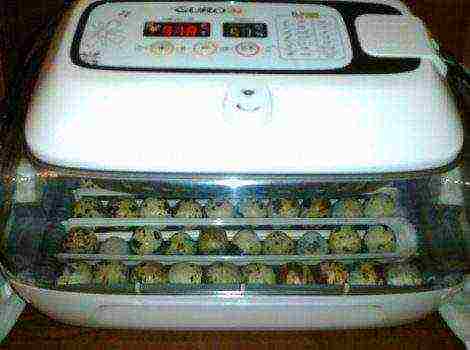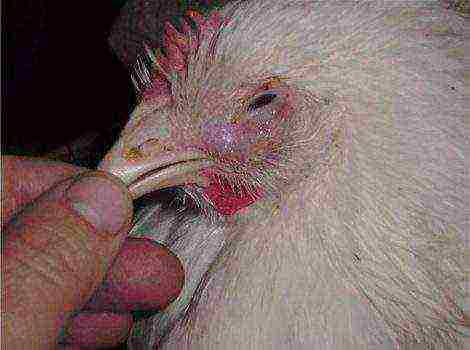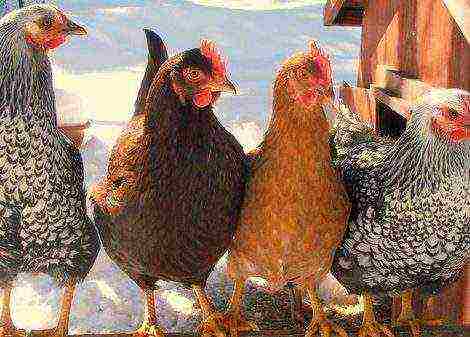Content
Breeding and keeping geese at home
Geese occupy a special place among poultry. If chickens are bred mainly for the purpose of obtaining eggs, then geese are raised for the sake of tasty, juicy meat.
Although it is inferior in dietary characteristics to chicken due to its high fat content, it is still very useful. It contains trace elements and vitamins A, C, B, including B12, which is deficient for many, mineral components - iron, zinc, manganese. Goose meat is especially appreciated for its amino acid content, from which antibodies against viruses are produced in our body.
In this article, we will take a closer look at breeding, keeping and caring for geese at home for beginners. We will find out if it is possible to eat goose eggs, how they are useful and how much they can cost. After reading all the information, you will be able to raise healthy and strong birds.
How to breed and raise geese at home for beginners?
First, let's talk about breeding geese at home. The specificity of keeping geese is that they cannot be raised in cages, like chickens. This explains why their population is much smaller. It is advisable to breed this bird in the event that there is a place nearby for them to walk - a pasture with a reservoir (rivulet or lake). Geese need space. They have to walk and move a lot. Because of this, their meat is darker than chicken meat (there are more blood vessels in the muscles).
Breeds of geese for breeding
The most common breeds are as follows:
Large gray geese - weigh 6-7 kg. Egg production is 37-47 eggs. Eggs are large - 150-200 g. Very hardy.
Chinese geese - live weight reaches 5 kg. Egg production - 50-60 pieces per year with a weight of 130-170 g. They are hardy, but aggressive by nature.
Lindovskaya breed - the mass of adult geese is 7-8 kg. Egg production is 45-50 eggs with an average weight of 120-140 g.
The Kuban is a domestic breed. Egg production - 80-90 eggs per year. Average live weight -4.5-5.5 kg.
Kholmogory - weigh more than other breeds - 8-10 kg. But egg production is 30-40 eggs per year, but their weight is more than 200 g. They are calm and non-aggressive.
Italian geese - are characterized by high productivity of meat. Live weight - from 6 to 7 kg. Egg production - up to 50 eggs per year.
Toulouse - French breed. It is considered the largest with a weight of 10 kg or more. Egg production - 30-40 eggs per year with an egg weight of 190-210 g. They are calm and inactive, feed well and quickly.
Emden geese weigh 8-9 kg. Egg production is low.
Rhine - bred in Germany. In terms of their characteristics, they are similar to those of Emden.
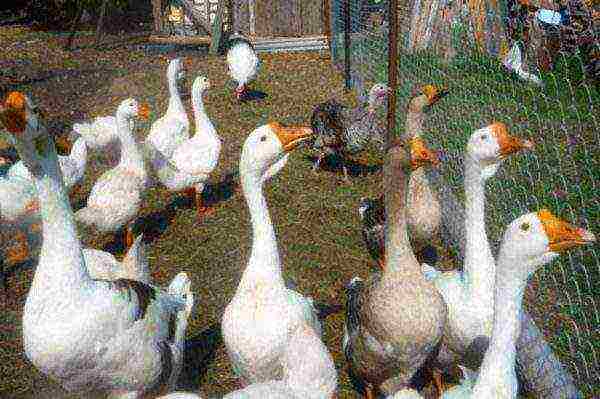
Hen eggs
It is better to hatch geese chicks from an egg with a brood hen, than in an incubator. However, if there is only one hen in the poultry farm, then a maximum of 13-14 heads are obtained for the brood, since the eggs are large. If you still choose this method of obtaining chicks, then first create the necessary conditions. Temperature indoor supported at the level of 14-15 degrees.
It should be dry and well ventilated, but free from drafts. The nest for the goose is made spacious.Be sure to separate it from the rest of the livestock and fence off the nests with partitions between themselves (in case there are several hens). Keep hens separate from the rest of the geese. This is due to the fact that geese can lay eggs in an already hatched clutch during the absence of the expectant mother. Thus, the period for obtaining goslings will stretch in time, which is very bad for their further development.
We monitor the dryness in the nest. An accidentally broken egg must be urgently removed and the rest of the survivors wiped up. The need to make partitions between nests is explained by the fact that in the absence of one hen, the other rolls several eggs to itself, since their maternal instinct is very developed.
We make sure that when the hens return to the nest after the necessary exercise, food intake and water procedures, they occupy their nests, and not confuse them with the neighbors. During incubation, we change the water in the drinking bowl of the future mother every day to avoid diarrhea and feed it only with selected grain. The hen will take care of all the hatching processes herself.
She herself rolls the eggs in the nest for even heating. If for some reason the goose does not return to the nest after eating for 20 minutes, it is driven onto the nest. This happens mainly with a bird sitting on eggs for the first time.
The first chicks appear on the 28th day. After that, they are taken from the nest, placed in a separate box, illuminated with a lamp, creating the desired temperature. After all the chicks are born, they are returned to the goose. In the first two days, mom can put several chicks from eggs hatched in the incubator. Do this in the evening.
Eggs in an incubator
Breeding chicks geese in an incubator harder than chickens... This is due to the fact that goose eggs contain a lot of fat and are large in themselves. If more than 70% of chicks hatched from one bookmark, then this is a good result. Several features of the incubation of goose eggs:
- take away them within 10 days - no more;
- preliminary 3-4 hours before bookmarking the incubator is warmed up with an elevated temperature of 39 degrees;
- take away only healthy perfect shape eggs;
- you can't wash them, but disinfection can be carried out by spraying with a light solution of potassium permanganate;
- the first 4-5 hours after setting the temperature in the incubator withstand at around 38 degrees... Then it is reduced to 37.8. The last couple of days it has been reduced to 37.5 degrees;
- eggs are turned 6-8 times a day to prevent the shells from sticking to the mesh or mold and for uniform heating;
- so that harmful gases do not accumulate, the incubator periodically after 15 days of laying open for 10 minutes to ventilate.
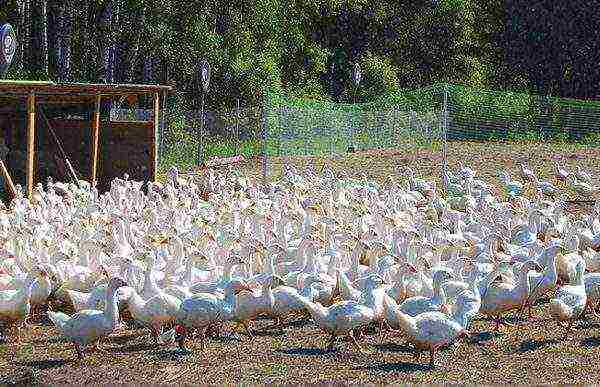
How to care for, raise and keep goslings
It is extremely important to care for goslings at home from the first days of life.
With the beginning of life, the immune system of the body of goslings is formed and strengthened. therefore it is important to have a balanced dietto grow a large and healthy bird. For each period of growth and development, its own diet is compiled. Feeding the newly hatched goslings is also extremely important.
Care for goslings in the first days of life
When caring for goslings at home, for the first 5-7 days, it is useful for chicks to give the yolk of boiled eggs. It is well absorbed by the immature organism of goslings. When feeding, it is recommended to add greens. Better to eat this green onion feather. It is finely crumbled and mixed with the yolk. During the first two days, the hatched goslings are fed 7-8 times a day.... It depends on this whether you will be able to raise healthy geese.
We make sure that the enclosure where they are kept is dry.
Care in the first weeks: how to raise healthy geese
Gradually, the diet is diversified with herbs and increases its presence in the feed. In addition to green onions, alfalfa and clover are given. We monitor the availability of clean water in the drinking bowls. Gradually, we introduce boiled potatoes and corn porridge into the diet.
Drinking bowls are replaced with more voluminousso that the goslings can swim in them. They turn into small bodies of water. To do this, use pots or bowls, but with low sides. This is a prerequisite.
The presence of the required amount of nutrients and vitamins in food will be provided by chopped root crops and vegetables. If we cook porridge for goslings, that they should not be too liquid. It is recommended to give more dry food.
We gradually transfer the three-week-old goslings to pasture. It is advisable that they graze in an outdoor enclosure. Together with the grass, they eat compound feed and crushed grain..
Care in the first months
How to care for goslings at home? Starting from this period, goslings are intensively fed with compound feed, grain, sunflower cake and greens. They are grazed in an open small reservoir without a strong current. In addition to grass, they eat algae, which has a positive effect on the development and growth of body weight.
The proportion of greens to all other feeds should be 1-1.3: 1. That is, greens give more. In this case, the content of goslings will be cheaper and this will not affect the set of live weight.
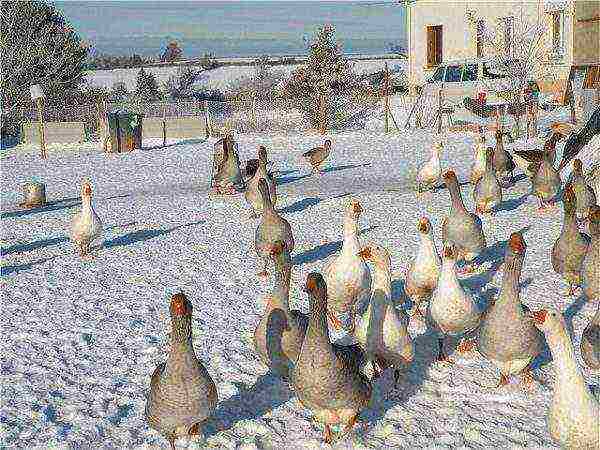
Conditions of keeping and feeding
In addition to food and water, goslings need an appropriate ambient temperature, sufficient room volume, and lighting.
Choosing an aviary for a goose farm
Depending on the number of livestock, we choose the appropriate room. In the early days, goslings are kept in cardboard boxes on the veranda, in the summer kitchen. Then they are given a place in the poultry house, shed. It must be well ventilated (ventilation) and warm, no drafts allowed. It is necessary to exclude the possibility of predatory animals entering there, primarily rats.
Straw and floor are used as bedding. We change the litter every 2-3 days to keep it dry. This will save the still immature chicks from diseases and hypothermia. The presence of a window into the room is a prerequisite. Geese love to be in a closed dark space only during sleep.
After 40 days, they are grazed near water bodies. But until they have grown stronger, and are not able to defend themselves on their own, the presence of a person is mandatory. As soon as the live weight reaches an average of 2 kg (depending on the breed), geese are released on their own to graze.
It is better to do this in the early morning - the grass is then juicy and nutritious. Geese find food for themselves. They are perfectly oriented in space, so they can easily find their way home. Adult geese have their wings clipped to prevent them from flying away.
Daily temperature regime and lighting
In the first week of life, we maintain the temperature at 28-30 degrees. If the natural ambient temperature is not enough, heating with heating pads or lamps, which, in addition to light, give heat to the room. We measure the temperature at the level of the litter.
We gradually reduce it to 22-24 degrees. And after three weeks, if the weather permits, we transfer the goslings to the mode of life in natural conditions. In general, adult geese are quite hardy birds due to their presence of fat, large live weight and warm plumage.
They can freely withstand temperatures up to minus 15 degrees. There should be enough lighting to maintain normal conditions with extended daylight hours (more than 14 hours). For this purpose, lamps are used.
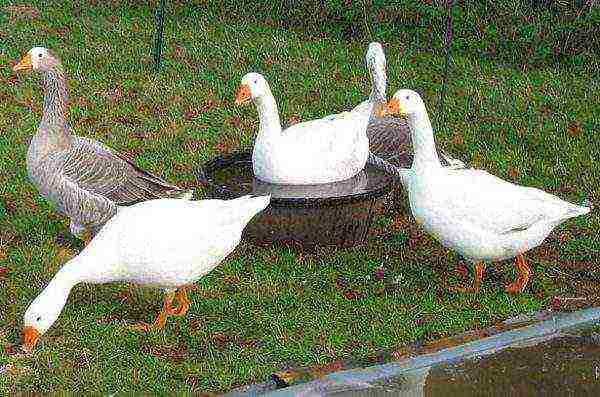
Room dimensions
The main condition for the size of the room for goslings is that it should not be crowded.
Provide free access to food and water. When the young grows up, it is recommended to release them in the fresh air into specially fenced pens during the day. At night they are in the barn (goose-house).
Geese rearing period
Now we will find out how many geese grow. If day-old chicks weigh only 100 grams, then after 5 months their weight reaches 5-6 kg. On average, this bird gains more than one kilogram per month. In order for the geese to be healthy, and the live weight reached good weight indicators, you need to carefully and carefully monitor their diet.
The weight of adult geese of different breeds varies from 4.5 kg to 10 and more. If you plan to breed geese for meat, then it is advisable to keep them up to two to three months of age. During this period, they gain 50% of the mass of an adult one-year-old bird. Further, the weight gain is suspended.
Goose eggs: how much can you eat and how are they useful?
Depending on the breed, geese produce between 30 and 90 eggs per year. They differ in their size (up to two hundred and twenty grams) and thick shell. They can be used in food and it is healthy, but due to the fact that they contain a lot of fats, they need to be eaten in moderation. Our ancestors ate eggs of geese 7 thousand years ago. This is the first domesticated bird.
100 g of raw eggs contains 185 kcal, including proteins and fats - more than 13 g. They include vitamins K, D, E, A, B, micro- and macroelements. Their use has a positive effect on the brain and genitourinary system, the elimination of toxins. The goose egg is widely used in cooking and cosmetology.
Now you know that breeding and keeping geese at home is profitable. Indeed, in addition to the quick return of meat, geese provide us with eggs and down. For the successful rearing of geese, it is advisable to have a pasture and an open reservoir. In this case, with sufficient care and proper nutrition, their maintenance will pay off many times over. Perhaps even in the future, goose breeding will become your main source of income.
